|
|
|
Sort Order |
|
|
|
Items / Page
|
|
|
|
|
|
|
| Srl | Item |
| 1 |
ID:
171172
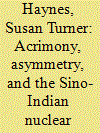

|
|
|
|
|
| Summary/Abstract |
While most contemporary analyses of South Asian nuclear dynamics acknowledge the presence of a strategic triangle between the region’s three nuclear players, the primary focus usually remains on the rivalry between India and Pakistan. Discussions of Sino-Indian relations remain limited. This is likely attributed to the stability in the two countries’ relations, yet it is worth asking why this stability exists and whether it is likely to continue in the future. Although China and India have an acrimonious relationship, their asymmetric nuclear capabilities and threat perceptions mitigate the danger of a traditional security dilemma. India may perceive China’s nuclear aggrandizement to be a security threat, but the same is not true of China, which has a vastly superior nuclear force and is largely shaping its nuclear-force structure in response to the threat it perceives from the United States. This dynamic makes a serious conventional or nuclear conflict highly unlikely.
|
|
|
|
|
|
|
|
|
|
|
|
|
|
|
|
| 2 |
ID:
066669
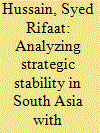

|
|
|
| 3 |
ID:
167675
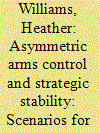

|
|
|
|
|
| Summary/Abstract |
Can arms control incorporate emerging technology? Other articles in this special issue identify potential risks emerging technologies pose to stability and how they are intertwined with international politics. Is there a future for multilateral strategic arms control? This article looks ahead to explore how arms control might reduce those risks but in order to do so we must update concepts of both arms control and strategic stability. Building on Thomas Schelling and Morton Halperin’s seminal study into the relationship between strategic stability and arms control, this article offers an original framework – asymmetric arms control – for incorporating new technologies, which is then used to identify six scenarios for arms control of hypersonic glide vehicles (HGVs). It concludes that arms control can potentially reduce the risks to strategic stability associated with emerging technologies by incorporating dynamism into arms control design. Ultimately, asymmetric arms control can best contribute to strategic stability by crossing domains and reflecting the cross-domain nature of international conflict, and the framework has potential application to emerging technologies beyond HGVs.
|
|
|
|
|
|
|
|
|
|
|
|
|
|
|
|
| 4 |
ID:
154781
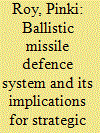

|
|
|
|
|
| Summary/Abstract |
The technological evolution and proliferation of ballistic missile defence (BMD) systems in the last two decades have ushered in the beginning of a new wave of strategic concern amongst security experts. The BMD attempts to unbalance the global strategic stability primarily founded on the strategy of nuclear retaliation. President George W. Bush administration further aggravated this threat to the global security order when he unilaterally withdrew the support of the United States (US) from the Anti-Ballistic Missile (ABM) Treaty. The approach of the US to strengthen its defence system has pushed other states to either pursue their own costly BMD system or reassure themselves through some new offensive strategies such as increasing number of nuclear arsenals. South Asia has not remained untouched from these global developments. In recent years, this region has witnessed a rapid proliferation of defensive and offensive ballistic missiles. This article aims to analyse the functioning of BMD system and its causal relation to the nuclear deterrence. In the context of South Asia, it seeks to explore the triangular strategic relationship among India, China and Pakistan within the broader framework of their BMD system.
|
|
|
|
|
|
|
|
|
|
|
|
|
|
|
|
| 5 |
ID:
144936
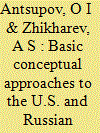

|
|
|
|
|
| Summary/Abstract |
The authors offer a comparative analysis of the approaches taken in Russia (U.S.S.R.) and the United States to the deployment of their strategic antiballistic missile defense systems, and survey the major stages of ABM system development. They show the influence the U.S. military doctrine has exercised on the formation of the country's ABM defense and its intention to take advantage of the new world order to use its ABM system for a different purpose instead - delivering a first nuclear missile strike with impunity.
|
|
|
|
|
|
|
|
|
|
|
|
|
|
|
|
| 6 |
ID:
144291
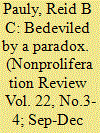

|
|
|
|
|
| Summary/Abstract |
This article explores how two influential American policy makers—Paul Nitze and McGeorge Bundy—wrestled with the idea of a norm against the use of nuclear weapons. Existing scholarship has overlooked how both Bundy and Nitze came to understand the idea of nuclear non-use, especially related to the credibility of threats to use nuclear weapons. Using documentary evidence from their personal papers, this article illuminates the thinking of Bundy and Nitze, finding that both engaged with the idea of a norm of non-use of nuclear weapons in their strategic writing and thought.
|
|
|
|
|
|
|
|
|
|
|
|
|
|
|
|
| 7 |
ID:
124314
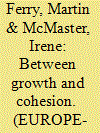

|
|
|
|
|
| Publication |
2013.
|
| Summary/Abstract |
THE ISSUE OF REGIONAL DEVELOPMENT IS HIGH ON THE POLICY agenda in Central and Eastern Europe (CEE). Indeed, for a variety of reasons, these countries are currently seen as some of the most interesting 'laboratories' for regional development in the European Union (EU) and beyond. First, from a situation in the early and mid-1990s where ?nances for regional development in these countries were very limited, there are now signi?cant levels of funding available. These ?nances ?ow predominantly from the structural funds available under EU cohesion policy, of which CEE member states are the biggest bene?ciaries in the EU. As the contribution by Ferry and McMaster notes, this brings with it opportunities to expand the scope and impact of regional development interventions. However, it also puts pressure on regional policy systems in these countries to develop structures and processes to absorb the funds, to ensure that they contribute to strategic economic growth, and to maintain a clear vision for domestic regional development.
|
|
|
|
|
|
|
|
|
|
|
|
|
|
|
|
| 8 |
ID:
143302
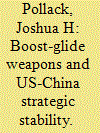

|
|
|
|
|
| Summary/Abstract |
The United States and China are testing boost-glide weapons, long-range strike systems capable of flying at Mach 5 or faster through the upper atmosphere. For the United States, these systems would provide a conventional prompt global strike capability, which, together with US ballistic missile defense programs, Chinese experts regard as a threat to China's ability to conduct nuclear retaliation. This perception is encouraging the Chinese military to modify its nuclear posture in ways that tend to create greater risks for both sides. If China's own boost-glide systems are meant to carry nuclear payloads only, their deployment would not fundamentally alter the current situation between the two states. However, if they were conventionally armed or dual-purpose, or if the United States could not determine the payloads they carried, the deployment of Chinese boost-glide systems could compound problems of strategic stability created by the introduction of ballistic missile defense, antisatellite, and antiship ballistic missile capabilities. If the technical hurdles can be overcome, it may be difficult for the two sides to refrain from these deployments in the absence of strong mutual trust or an established arms-control relationship. New confidence-building measures and expanded mutual transparency are warranted to avoid creating new dangers.
|
|
|
|
|
|
|
|
|
|
|
|
|
|
|
|
| 9 |
ID:
087074


|
|
|
|
|
| Publication |
2008.
|
| Summary/Abstract |
Canada has contributed to North American strategic defence, and been an ardent propent of strategic stability, since the early Cold War. Though seemingly comatible, Canada's involvement in continental strategic defence and advocacy of strategic stabiligy has been nagged by an underlying contradiction.
|
|
|
|
|
|
|
|
|
|
|
|
|
|
|
|
| 10 |
ID:
087988
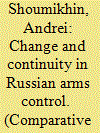

|
|
|
|
|
| Publication |
2009.
|
| Summary/Abstract |
Russian arms control is not a brand new creation disembodied from the past but is heavily influenced by the history of arms control in the Soviet era. Tracing the evolution of Russian thinking from the days of Stalin, through the arms control boom of the 1970s, to the reforms of Gorbachev and the Soviet disintegration, this article flushes out the Soviet perspective on issues such as strategic stability and the use of treaties to slow an adversary's technological advancement. Further, this article relates the influence of Soviet opinion to current-day thinking in the Russian Federation (RF). As the U.S. and the RF prepare to tackle tough issues, like the expiration of the Strategic Arms Reduction Treaty in 2009, these viewpoints become particularly salient.
|
|
|
|
|
|
|
|
|
|
|
|
|
|
|
|
| 11 |
ID:
137239
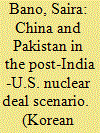

|
|
|
|
|
| Summary/Abstract |
Nuclear relations in South Asia cannot be fully analyzed without taking into account the China factor. After the May 1998 nuclear tests, a substantive amount of strategic literature has been focused on Indian and Pakistani nuclear postures and policies, respectively. However, their integral links with China in transforming South Asia’s nuclear environment remains one critical component that has not
been adequately examined. Multifaceted cooperation, competition and conflict have engulfed this triangle since the India-U.S. nuclear deal. This deal has significantly increased India’s nuclear weapons capability, and hence exacerbated the security dilemma of Pakistan and China, which has important implications for the strategic stability in the region. This paper analyses the strategic implications of this deal for the nuclear triangle and argues that the nuclear triangle will remain complex with inherent risks as well as pose challenges to the region’s strategic stability. China-India-Pakistan nuclear strategies will be determined by the larger triangle of U.S.-China-India relations, which will define the politics of South Asia as well as the larger Asian landscape.
|
|
|
|
|
|
|
|
|
|
|
|
|
|
|
|
| 12 |
ID:
111130
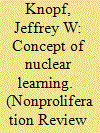

|
|
|
|
|
| Publication |
2012.
|
| Summary/Abstract |
This article seeks to elucidate the concept of nuclear learning. It explores both the "nuclear" and the "learning" aspects of the concept. On the nuclear side, it distinguishes between learning basic facts about nuclear arms and drawing inferences about the larger implications of those facts. On the learning side, it discusses three issues: whether to use the term in a normative or value-neutral manner; the difference between learning that leads to a change in means versus learning that leads to a re-evaluation of ends; and whether learning only takes place at the level of individuals or whether there can also be learning by collective entities. The article argues there is no universal best answer to these questions and that the particular concept of learning that should be employed depends on the goals of the analyst. If the goal is to reduce the chances of nuclear war, however, one type of learning that will be important to consider is whether there is shared, cross-national learning.
|
|
|
|
|
|
|
|
|
|
|
|
|
|
|
|
| 13 |
ID:
182644
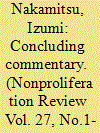

|
|
|
|
|
| Summary/Abstract |
The United Nations High Representative for Disarmament Affairs offers concluding thoughts on this special issue of the Nonproliferation Review, highlighting recent work that the international community has undertaken on the challenges of long-range conventional weapons, and offering recommendations for ameliorating the effects these weapons may have on strategic stability and international peace and security.
|
|
|
|
|
|
|
|
|
|
|
|
|
|
|
|
| 14 |
ID:
172904
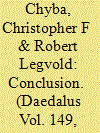

|
|
|
| 15 |
ID:
182642
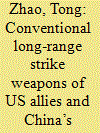

|
|
|
|
|
| Summary/Abstract |
Conventional long-range strike weapons of US allies may exacerbate Chinese concerns about the survivability of its small nuclear arsenal against a precision pre-emptive strike from the US-led coalition, although the degree of the new threat depends on various factors including the numbers and types of such weapons to be deployed. Conventional hypersonic missiles, in particular, may generate acute threat perception, as they can play the role of “door kicker” against China’s so-called anti-access, area-denial capabilities and pave the way for subsequent massive strikes with more traditional weapons. The development of conventional long-range-strike weapons by US allies also affects the risk of conventional conflicts escalating inadvertently to the nuclear level. Such risks are particularly salient in the Asia–Pacific region because of at least two factors: the ambiguous role of Chinese theater nuclear weapons and significant entanglement of conventional and nuclear capabilities at the theater level. Such conventional capabilities of US allies also help shape the region’s overall military balance—something China treats as part of its broader understanding of the term “strategic stability.” Regional players, however, have competing visions about what constitutes a stable military balance. They also have conflicting interpretations of why other parties are pursuing conventional long-range-strike weapons. The development of such capabilities will pose growing challenges to regional strategic stability in the future.
|
|
|
|
|
|
|
|
|
|
|
|
|
|
|
|
| 16 |
ID:
166211
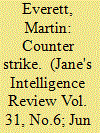

|
|
|
| 17 |
ID:
189139
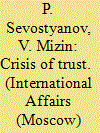

|
|
|
|
|
| Summary/Abstract |
THE OUTBREAK in 2020 of the coronavirus pandemic coincided with a sharp deterioration in relations between Russia and the leading NATO countries, headed by the US. For the first time in the 30 years since the end of the Cold War, officials and experts have started expressing fears about the possibility of an armed conflict between the parties.
|
|
|
|
|
|
|
|
|
|
|
|
|
|
|
|
| 18 |
ID:
182960


|
|
|
|
|
| Summary/Abstract |
This article explores the potential for new biotechnologically enabled weapons to compete with nuclear weapons in the context of strategic stability, assesses how such new technologies may affect assumptions in traditional strategic-stability models when applied to such scenarios, and how changing capabilities and adversaries may shape approaches to nonproliferation, verification, and monitoring. Among the most recent additions to the genome-editing arsenal is CRISPR (clustered regularly interspaced short palindromic repeats), a bacteria-derived system that is among the simplest genome-editing tools. The CRISPR-Cas9 system—and emerging variants of the system—enables unprecedented control and ease when editing the genome. With parallels to remote “command and control” of the genome, this aspect makes the technology different from earlier gene-editing methods. This article furthers the scholarly work on the biosecurity implications of CRISPR, gene editing, and broader issues of biotechnology by addressing these emerging life-science technologies in the context of nuclear strategic stability and implications for balance of power, nonproliferation, and international security.
|
|
|
|
|
|
|
|
|
|
|
|
|
|
|
|
| 19 |
ID:
132721


|
|
|
|
|
| Publication |
2014.
|
| Summary/Abstract |
space systems play an important role in sustaining the development, prosperity and security of many nations. As more nations become critically reliant on space systems, questions of maintaining safety and strategic stability in outer space have come to the fore. Transparency and Confidence-Building Measures (TCBMs) for outer space activities have an important role to play in providing clarity about the intentions of States and in articulating norms of behaviour in outer space. TCBMs take several forms. They may be the elaboration of basic principles related to the exploration and use of outer space, political measures related to establishing norms of conduct, information-sharing activities to improve the transparency of outer space activities, operational practices which demonstrate a commitment to mutual cooperation in outer space, or consultative mechanisms. We present an analytical framework for evaluating potential TCBMs and illustrate the application of this framework to examples of potential operational, regulatory, treaty-based and declaratory TCBMs.
|
|
|
|
|
|
|
|
|
|
|
|
|
|
|
|
| 20 |
ID:
174873
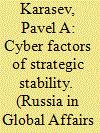

|
|
|
|
|
| Summary/Abstract |
It is hard to disagree with most international relations experts that nuclear arms control is currently undergoing a systemic crisis. Opinions differ on its depth and possible ways out of it. At the same time, many experts consider it necessary to conceptualize the factor of the latest information and communications technologies (ICTs), including artificial intelligence (AI) systems, in the domain of strategic stability. The matter concerns not only the digitalization of nuclear communications, command, control, and intelligence systems (C3I), but also the development and use of lethal autonomous weapons systems (LAWS).
|
|
|
|
|
|
|
|
|
|
|
|
|
|
|
|
|
|
|
|
|